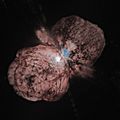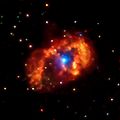Luminous blue variable facts for kids

Luminous blue variables (LBVs) are huge, old stars. They change their brightness and the light they give off in surprising ways. These changes can be very dramatic.
These unstable supergiants or hypergiants are also called S Doradus variables. This is because a very bright star named S Doradus in the Large Magellanic Cloud is one of them.
LBVs are super rare! Only about 20 are listed in the General Catalogue of Variable Stars. Some of these are not even thought to be LBVs anymore.
When they are not changing much (their "quiet" state), they are usually B-type stars. They can be very hot and have unusual emission lines in their light. You can find them on a special star chart called the Hertzsprung–Russell diagram. This area is known as the S Doradus instability strip.
The least bright LBVs are about 10,000 K (degrees Celsius) hot. They shine with a light about 250,000 times brighter than our Sun. The brightest ones can be 25,000 K hot. They shine over a million times brighter than the Sun! This makes them some of the brightest stars in the whole universe.
How We Found LBVs
Some LBV stars, like P Cygni and Eta Carinae, have been known for a long time. People noticed they were unusual stars way back in the 1600s. But scientists only truly understood what they were much more recently. The name "S Doradus variable" was first used to describe this group of stars in 1974. AE Andromedae is another very bright luminous blue variable. It is found in the Andromeda galaxy, which is also called M31.
Images for kids
-
The Homunculus Nebula was made by a huge explosion from the star η Carinae.
-
η Carinae, a luminous blue variable, as seen by the Chandra X-ray Observatory.
-
HD 168607 is the star on the right, below the Omega Nebula. The other star next to it is the hypergiant HD 168625.
See also
 In Spanish: Variable luminosa azul para niños
In Spanish: Variable luminosa azul para niños







